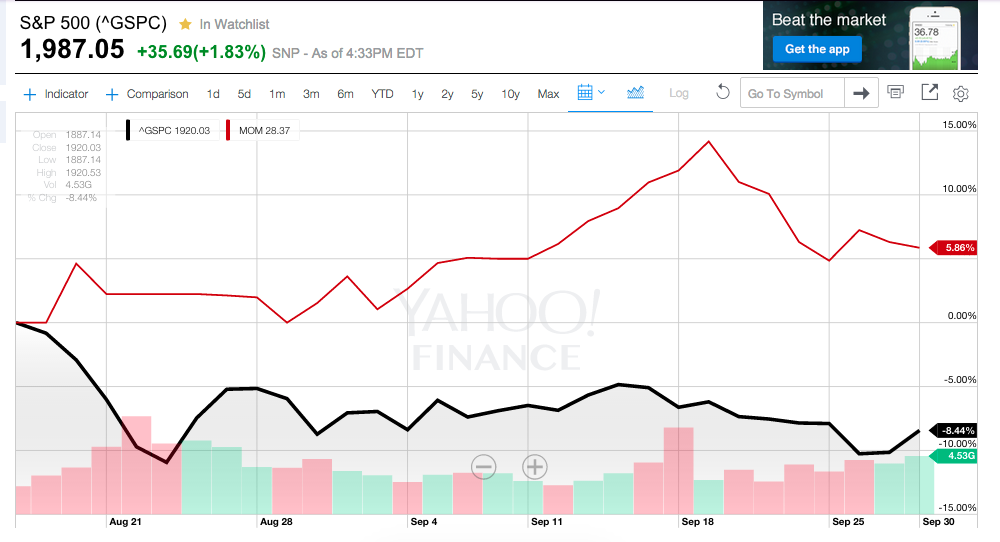
Between August 17th and September 30th, the S&P 500 Index declined by almost 8.5%, but the MOM ETF appreciated by almost 5.9%!
One of the surprising (and often rewarding) features of my job as an “Investment Ideas” writer is starting research on an article with one expectation in mind… but then having that expectation transformed in totally unexpected ways by information that I uncover.
Such is the case with my follow-up to the article regarding the performance of “Low Volatility” ETFs through the second half of August 2015. [See https://www.markettamer.com/blog/etfs-and-the-sec-sledgehammer-on-black-monday ]
After I finished that article, I looked at the “Black Monday” event from a different (opposite) angle: namely, if ‘Low Volatility’ ETFs[1] were whacked on August 24th, how did ‘Momentum’ ETFs perform?” [My presumption was that the momentum funds would be negatively impacted to a degree even greater than the low volatility funds.]
So I reviewed a long list of some of the more commonly used “Momentum ETFs” and came up with the following list of funds that I discerned would be most helpful in an analysis:
First Trust Dorsey Wright Focus 5 ETF (FV)
iShares MSCI USA Momentum Factor (MTUM)
PowerShares DWA Momentum ETF (PDP)
QuantShares US Market Neutral Momentum (MOM)
First, let’s see how the Momentum ETFs fared on “Black Monday”:
1) Just for perspective, let’s review what we learned in the previous article:
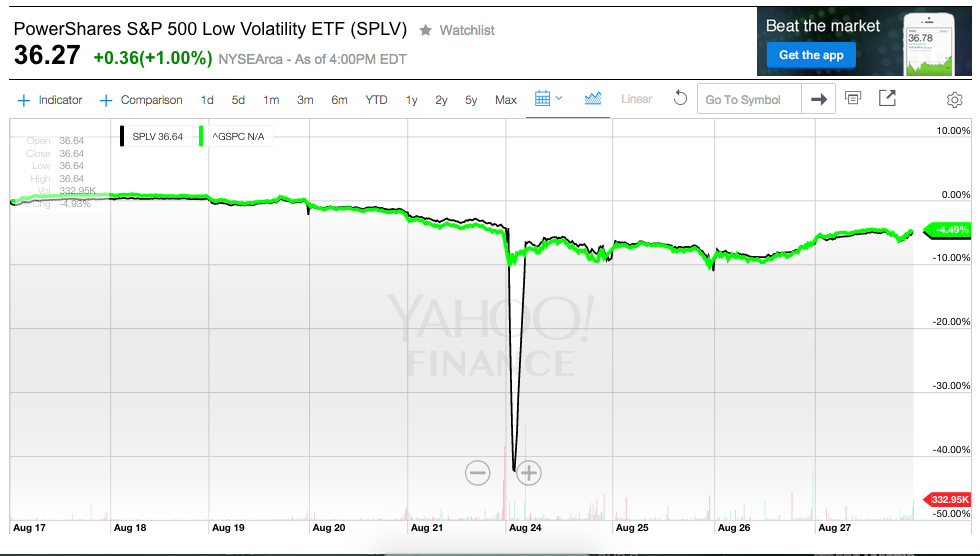
Although at its worst level during August 24th, the S&P 500 Index was only down `by 6.6%, the Powershares S&P 500 Low Volatility ETF (SPLV) collapsed by over 40%!
2) Let’s add
First Trust Dorsey Wright Focus 5 ETF (FV) and
iShares MSCI USA Momentum Factor (MTUM) to this chart:
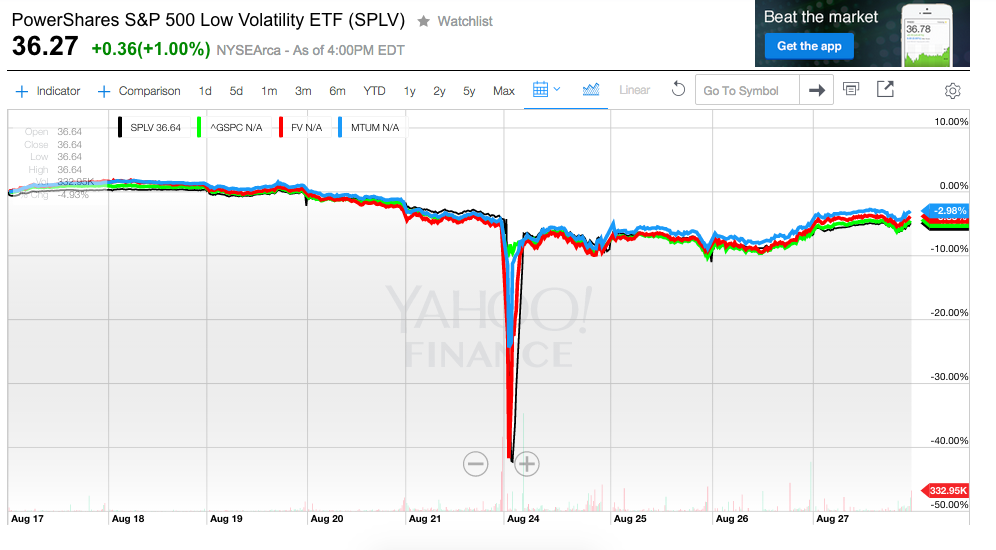
We can see that on Black Monday, FV joined SPLV in that deep crater about 40% lower than the closing price from the prior Friday. However, MTUM only dropped about 25% at its worst point! So my presumption that momentum funds would suffer more downside than low volatility funds was off-target!
If you are curious regarding the relative performance of these funds between August 17th (the Monday prior to “Black Monday”) and August 28th (the Monday following “Black Monday”) here are the numbers:
S&P 500 -4.49%
SPLV – 5.01%
FV -3.83%
MTUM -2.98%
MOM -2.53%
Therefore, all three of these Momentum ETFs outperformed the S&P 500 Index and the Powershares S&P 500 Low Volatility ETF (SPLV) during that period!
The price action that particularly caught my eye as I reviewed this late August period was that of the QuantShares US Market Neutral Momentum (MOM). Quite honestly, what grabbed my attention was its much more “herky-jerky” price pattern, which can easily be accounted for by virtue of its relatively low asset base ($1.3 million) and low average daily trading volume (1,405… over the most recent three month period). In contrast, comparable daily volume metrics from the other ETFs are as follows:
FV 2,586,020
MTUM 152,850
PDP 325,912
Seeing how MOM handled “Black Monday” and the latter half of August prompted me to check on MOM’s performance during other time periods:
3) Year-to-Date through October 2nd:
S&P 500 -5.19% (the Black Line)
PDP -0.56%
FV +2.18%
MTUM +1.69%
MOM +18.17% (MOM is the Purple line)
Note that MOM’s outperformance was concentrated in January, early February, late March, early April, and then from August 6th onward[2]:
4) Here are these ETFs between August 1 and September 29:
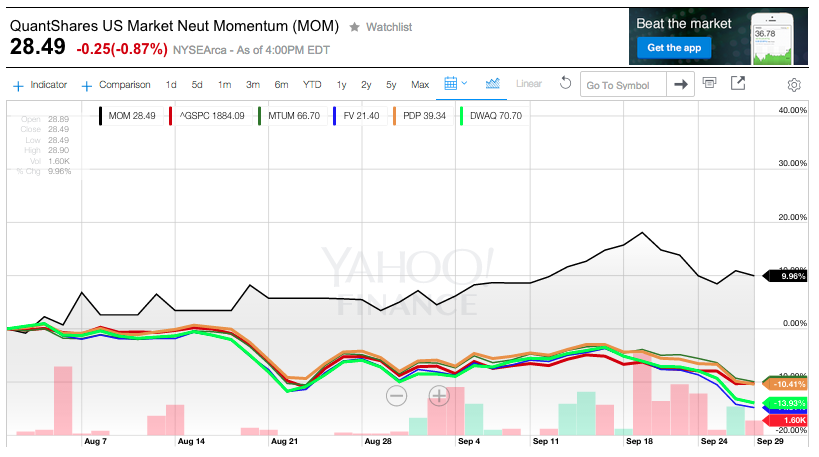
The only important take-away here is how thoroughly MOM outperformed the S&P 500 Index and the other ETFs.
In an effort to counter-balance what may be some excitement about MOM stirring within your imagination… here is a chart since March 2014 (just after FV was rolled out):
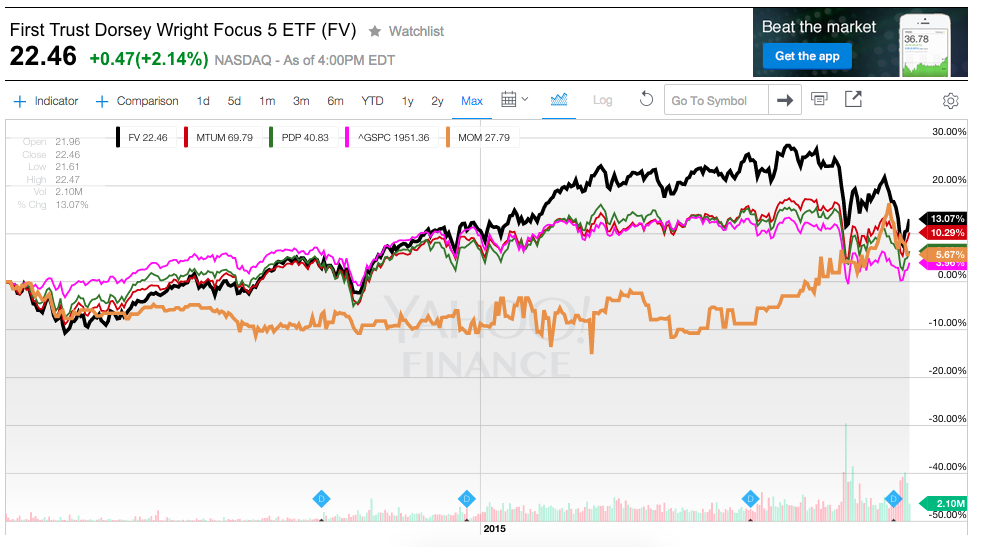
Note that MOM trailed the other ETFs and the S&P 500 Index through the first three-fourths of this time interval. However, once it caught fire, it made up most of the difference quite dramatically. During this period, while FV was the top ETF at +13.07% and MTUM was just behind at +10.29%, MOM returned +5.67% (outperforming the S&P Index, but slightly trailing PDP).
5) Over an even longer period (January 2013 through October 2, 2015), here is how the ETF’s performed vis-à-vis the S&P Index:
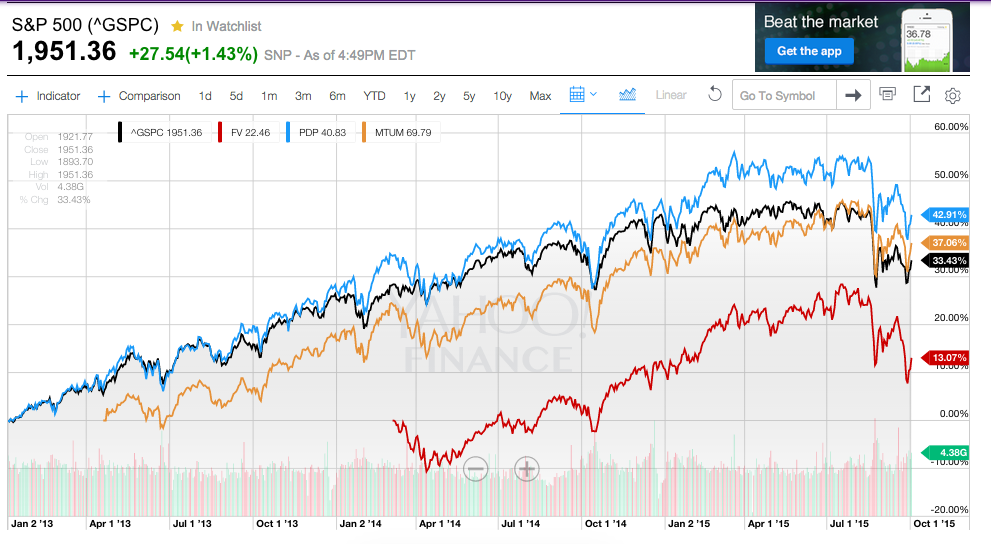
PDP led the pack at 42.91%, followed by MTUM at 37.08% … both outperforming the S&P 500 Index at 33.43%. As noted earlier, FV did not open for trading until February of 2014, so its 13.07% is not comparable.
6) You likely noticed that MOM did not appear above. I wanted the graph to be less crowded, so below is the price graph for the S&P Index and MOM during that same January 2013 through October 2, 2015 period:
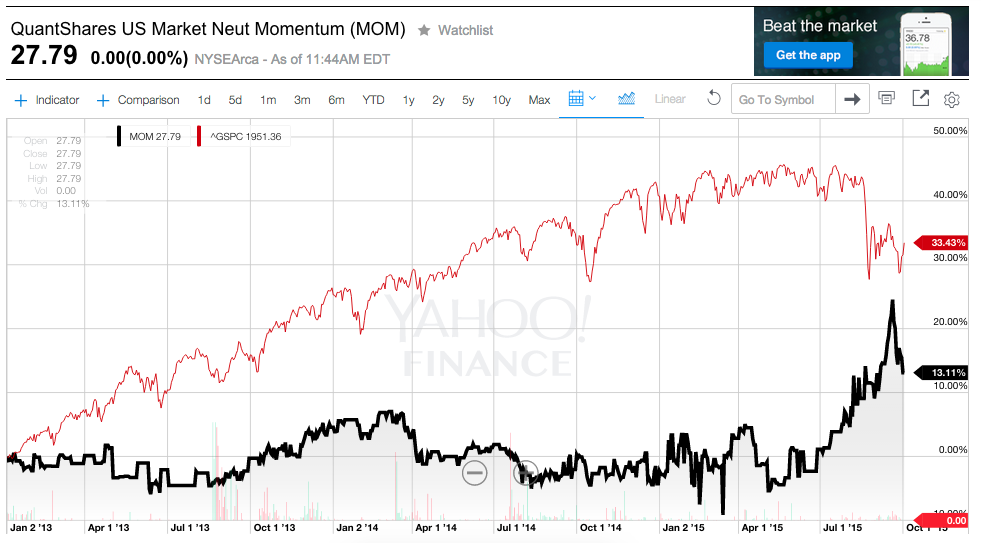
As you can see, MOM returned 13.11% compared to the S&P 500 Index’s 33.43%. However, notice the peculiar (nearly mirror image) pattern of MOM at the far right side of this graph!
What might have accounted for the rather unusual performance patterns demonstrated by MOM?
Let’s review the description offered by the sponsor of MOM (QUANT SHARES) within its website [I have added punctuation for emphasis]:
DESCRIPTION OF MOM:
“The Fund seeks performance results that correspond to the price and yield performance, before fees and expenses of the Dow Jones U.S. Thematic Market Neutral Momentum Total Return Index.
The target index, which is compiled by Dow Jones Indexes, is
1) equal weighted,
2) dollar neutral,
3) sector neutral and
4) is not levered.
The index rebalances monthly by identifying the highest momentum stocks as long positions and lowest momentum stocks as short positions, of approximately equal dollar amounts, within each sector.
The Exchange Traded Fund provides investors with the means of seeking the spread return between high and low momentum price stocks within the Dow Jones U.S. Index.
A stock's momentum is based on its total return, which is a function of price performance and dividend returns over the first twelve of the last thirteen months.
Stocks with a higher total return receive a higher ranking and stocks with a lower total return receive a lower ranking. Momentum investing entails investing in securities that have had above-average returns and shorting securities that have had below-average returns. The performance of the Fund will depend on the difference in the rate of return between its long positions and short positions.”
As you can see, MOM is an unusual fund, particularly within the “Momentum” category. Yes, it uses “Relative Strength” as a key metric to guide portfolio selection, but the applicable measure used is based upon the highest (or lowest) “Total Return” (change in market value plus dividends received). Instead of providing investors with return from strictly the highest momentum stocks, this fund focuses upon optimizing the spread between its long and short positions. The other primary characteristic of MOM is that this un-leveraged ETF is all of the following:
1) equal weighted,
2) dollar neutral,
3) sector neutral
Here are other key aspects of MOM:
1) It is re-balanced monthly.
2) If you examine the “Characteristics” listed on its website, you’ll note that it holds an equal number of long and short positions.
 In addition, its long positions skew toward having higher P/E and P/B Ratios than its short positions. The average Market Cap of longs is almost one third larger than the Market Cap of its shorts. And the short positions reflect a higher Beta than the long positions!
In addition, its long positions skew toward having higher P/E and P/B Ratios than its short positions. The average Market Cap of longs is almost one third larger than the Market Cap of its shorts. And the short positions reflect a higher Beta than the long positions!
From the image below, we can see that MOM endeavors to maintain an approximately equal “weighting by sector” within its long and short positions:
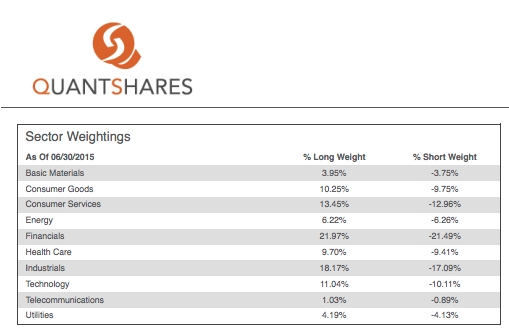 The top four sectors at 6/30/15 were:
The top four sectors at 6/30/15 were:
Financials
Industrials
Consumer Services
Technology
Here is the “Fund Performance” slide from the website (although I feel it could have been organized much more clearly):
Ever since I started investing many years ago, I have been drawn to the theory behind the “Long/Short” strategy utilized by MOM. On the surface, it might appear that picking stronger stocks and weaker stocks and then dividing one’s assets evenly between long positions (strong stocks) and short positions (weak ones) could offer a more successful strategy for (relatively) steady trading profits. One using that strategy would be unlikely to “hit home runs”, but the “spread” between stronger stocks and weaker stocks could be expected to provide an upward trend within one’s account balance. However, market data reveals that executing this strategy is not as easy as one might expect.
Just take a moment to compare the data below from Morningstar on recent U.S. Equity performance:
Note that (through October 2, 2015) the “Large Blend” category has returned (on average) as follows:
|
One-Year |
Three-Year |
Five-Year |
|
| Large Blend |
-1.00% |
11.24% |
11.63% |
Contrast those figures with the average returns from “Long/Short Equity”:
|
One-Year |
Three-Year |
Five-Year |
|
| Long/Short Equity |
-1.56% |
4.76% |
5.74% |
On a sustained basis, I would not complain about a “steady” annual return in the 5% range for a significant “Core” portion of my assets.. However, I understand I would definitely be in a minority among our readers on that score
Before we move to the “Investor Takeaway” section, I want to follow-up on the U.S. Securities and Exchange Commission (SEC) regulation section of our prior article: https://www.markettamer.com/blog/etfs-and-the-sec-sledgehammer-on-black-monday ]
In September, the SEC agreed to propose a comprehensive package of rule reforms intended to enhance “liquidity risk management” by mutual funds and ETFs. According to current law, mutual funds are expected to honor redemption requests within seven days. As a part of that law, funds (and ETFs) are urged to limit their investments in illiquid securities at 15 percent – but that parameter is not (yet) a legal requirement.
Here is what the Chairwoman of the SEC, Mary Jo White, says about this most recent regulatory effort:
“Promoting stronger liquidity risk management is essential to protecting the interests of the millions of Americans who invest in mutual funds and exchange-traded funds. These significant reforms would require funds to better manage their liquidity risks, give them new tools to meet that requirement, and enhance the Commission’s oversight.”
The proposal includes provisions that (supposedly) enhance disclosure requirements regarding fund liquidity and redemption practices. In particular, the regulations include multiple elements, including:
1) classification of the liquidity of fund portfolio assets based on the amount of time an asset would be able to be converted to cash without a market impact;
[Note: Who defines “without a market impact”; that could prove to be a stumbling block in rule interpretation!!]
2) assessment, periodic review and management of a fund’s liquidity risk;
3) establishment of a fund’s three-day liquid asset minimum; and
4) board approval and review.
5) Finally, the proposal codifies the 15 percent limit on illiquid assets included in current Commission guidelines.
All of the above being said, allow me to suggest that the “fox in the henhouse” is the section of the proposed SEC regulations that deals with a so-called framework under which mutual funds could elect to use “swing pricing”!!
What (pray tell) is “swing pricing”, you ask??

Quite frankly, it sometimes feels as though the SEC's attempts to reassure investors isn't as "reality-based" and well-tested as it needs to be -- somewhat like his bedtime storm about the "Three Little Pigs", that celebrates the "bricks" portfolio.
According to the SEC’s proposed regulation, funds could pass on the costs related to shareholder purchase or redemption activity by adjusting the price received by those trying to sell shares… depending upon market circumstances. Namely, funds would have the freedom to utilize “swing pricing” to enhance their liquidity management during periods of market stress. [Put simply, funds could process investors’ sell requests at a lower price than NAV under certain circumstances, resulting in an increase of fund revenue vis-à-vis current policy.]
At the risk of turning you into a cynic like me, what do you suppose the “baseline” result of this newest SEC regulatory effort (if it becomes finalized)?
1) Mutual funds will have an additional opportunity for “incremental revenue”
2) More frequent public portfolio “disclosure” by mutual funds:
a) Currently, funds are required to “disclose” holdings on a quarterly basis [Note: ETF’s must provide disclose on a daily basis].
b) This change would require funds to report to the SEC on a monthly basis.
3) Obviously, bigger funds will be more challenged to unload an “entire position” held in its fund “without a market impact” than smaller funds.
a) Case in point:
*The iShares Emerging Markets ETF (EEM ) holds 4.1 million shares of the National Bank of Abu Dhabi, which accounts for about 0.05 percent of its portfolio.
* Based on FactSet’s Portfolio Analysis tool, it would take about eight days to unload that stock.
* However, if another fund was half the size of EEM, it would take just four days to unload that stock.
* Therefore, for EEM, that bank position would be an “illiquid asset,” while for that smaller fund, the same position would not be an “illiquid asset”.
b) The potential consequence of the above example is that mutual funds would become more likely to close to “new investments”… or to compromise their portfolios with off-index-weight positions.
4) To be fair, the SEC has proposed some suggestions regarding the types of strategies funds might use to try to minimize the negative impact on larger funds of these new rules (they appear on page 404 of the SEC’s proposal…) but how likely is it that the SEC has a realistic sense of how to help funds manage these issues? And let me emphasize that these “helpful suggestions” appear on page 404 of the SEC document!!
5) Some sectors of the market will be more disadvantaged than other sectors
a) Some examples include:
i) Junk Bonds
ii) Senior Bank Loans
iii) Certain corporate bonds
b) One of the primary premises behind ETFs has been that they provide liquid access to some inherently illiquid assets.
i) This regulation may make this “plus” for ETFs quite problematic!
ii) Here is just one illustration:
iShares has published an excellent paper that points out the fact that, within the corporate bond space, ETFs now hold more in bond assets under management than the entire corporate dealer market has held in inventory.
6) Assuming a “worst case scenario” (that the SEC proposal becomes fully finalized and enacted)… there are ways “around” the worst aspects of the regulations!
a) Utilize “swaps”… ProShares offers several examples of funds run with a combination of cash and swaps.
i) The end result would be less efficient, but it would definitely evade the seemingly egregious complications of this new regulation.
b) The “Exchange Traded Note” structure might become more common
i) The issuance of ETNs has become less common in recent years;
ii) One reason for this is the reluctance by investors to depend upon the financial health of a bank for the security of their investment. [Note that an ETN is, in essence, a “bank note” promising a return matching the performance of a given index rather than a segregated portfolio of securities.[3]]
iii) Another reason is the hesitancy on the part of banks to accept the “hit” to their balance sheet required by post-crisis regulatory requirements [namely, a bank must make an offsetting balance sheet entry within its “living will” for such items as an ETN.]
iv) If this new proposed SEC regulation becomes final, the relatively more easy management of the ETN structure, combined with customer demand, might result in more ETN products coming to market.
- Do we really think that would be a positive development?[4]
It is reported that one of the motivating factors that prompted SEC commissioners to propose these “liquidity management” provisions is concern related to potential investor panic during periods of market stress.[5] One might suggest that it is no coincidence this proposal rose to the surface for a vote during the month following “Black Monday”.
In regard to potential investor “panic” and fund/ETF liquidity, allow me to offer some “headline” metrics from a report that emerged in September from Aon Hewitt (which tracks the 401 (k) plan trading activity of 1.3 million U.S. participants (representing approximately $160 billion in collective account value):
1) On August 24th (Black Monday) trading volume in those accounts was seven times the “normal” level;
2) During the prior trading day (Friday, August 21st) volume mounted to twice the historical level.
3) Generally speaking, investors moved assets from equity funds to fixed income funds.
Why is this significant? The fact is that 401(k) accounts are a vital “foundation” within the total United States retirement asset infrastructure [the following data is from benefitspro.com[6]]:
1) Within the entire pool of U.S. “Defined Contribution” plans, assets within 401(k) plans account for 66.67% of total “DC” plans;
2) If one combines aggregate IRA assets with aggregate “DC” assets – the combined total accounts for 57.5% of the entire pool of U.S. Retirement Assets ($24 trillion at June 30, 2014).
Therefore, if periods of market stress prompt U.S. investors to make excessive “short-term” changes within accounts that, by definition, should be thought of (and treated) as long-term assets — that could qualify as an issue deserving of attention by government regulators. It is not impossible that SEC staff persons and/or commissioners read some of those “headline numbers” from Aon Hewitt. In fact, perhaps the same “headline numbers” caught your attention.
However, one of the time-tested truisms of life is that metrics do not mean anything without “context”. So allow me to provide “context” regarding trading within 401(k) plans during the period surrounding “Black Monday”. [The facts below come from Aon Hewitt.]:
1) During a typical day, total trading within 401(k) plans amount to 0.02 to 0.03 percent of all assets.
a) That means that on an average day, no more than 3 basis points of total assets get traded.
b) Would you agree that 3 basis points is not material?
2) That means that 401(k) trading on August 21st jumped to a still modest 6 basis points.
3) Trading in 401(k) trading on “Black Monday” therefore totaled a hardly alarming 17 basis points.
4) The Director of Retirement Research at e, Rob Austin, and his staff study 401(k) matters and trading activity on a weekly basis. Following “Black Monday”, he offered a reassuring observation:
Both Austin and his Aon Hewitt team are confident that 401(k) investors are not running for the hills en masse. He characterizes trading since August 24th as “remarkably level.”
5) In particular, Austin notes that on September 1st, the Dow Index collapsed by 420 points….
a) And yet Aon Hewitt’s numbers document that 401(k) plan participants took that news very much “in stride”.
b) In the words of Austin: “It was just a normal day of activity” within 401(k) trading!
In case the above does not establish that August 24th did not cause any significant level of “investor panic” among 401(k) plan participants … a backbone within the U.S. Retirement Assets infrastructure… please note that there is additional evidence that the SEC may be a bit “off-track” on this issue.
In June of 2014, the U.S. Government Accountability Office (GAO), issued an official report that concluded that concern about “market timing” (or excessive trading) within 401(k) accounts is a “non-issue”! Therefore, this issue should not be considered a systemic problem!
I will leave it to you to discern whether this latest effort on the part of the SEC to regulate investments within the mutual fund and ETF space is more likely to be constructive in the years to come or more likely to (unintentionally) enhance the “sledgehammer” effect of the existing regulatory framework … as we witnessed on August 24th.
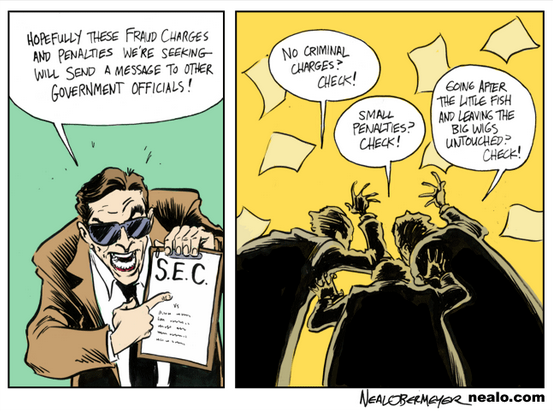
One of the persistent criticisms of U.S. financial regulators and authorities is inconsistent enforcement of regulatory violations.
INVESTOR TAKEAWAY:
The fact that I began my research with one presumed outcome in mind but ended up discovering that I was significantly “off the mark” should remind all of us that dynamics within the investment world include so many complex variables that logic itself is not sufficient to ensure that we will come to on-target conclusions.
Although I never recommend any particular investment to our readers, I will say that QuantShares US Market Neutral Momentum (MOM) may be worth keeping in the back of your mind for consideration during periods of extended uncertainty within the U.S. equity market and volatility, as we have experienced during portions of 2015. As I stated above, your returns will not likely qualify as “home run” like. However, it would appear that the “spread” garnered by MOM through its “Long/Short” portfolio could appeal to certain investors whose goal is a steadier, less volatile return over the intermediate to long-term horizon.
Finally, just because the SEC is chaired by an exceptionally bright woman (Mary Jo White) and is composed of persons with impressive resumes, there is never a guarantee that their regulatory work will actually prove to be constructive within the very complex and regularly changing network of U.S. securities markets! As I stated above (just to press home the point):
Dynamics within the investment world include so many complex variables that logic itself is not sufficient to ensure that we [or the SEC] will come to on-target conclusions.
DISCLOSURE:
The author does not own MOM or any of the other Momentum ETFs referenced above. However, he is considering MOM as a future investment. As regularly disclosed, the author does own positions in the S&P 500 Index, as well as the USMV ETF.
Nothing in this article is intended as a recommendation to buy or sell anything. Always consult with your financial advisor regarding changes in your portfolio – either subtractions or additions.
FOOTNOTES:
[1] We focused on PowerShares S&P 500 Low Volatility ETF (SPLV) and iShares MSCI USA Minimum Volatility (USMV)
[2] Especially from September 11 through September 25
[3] From Investopedia.com: “A type of unsecured, unsubordinated debt security that was first issued by Barclays Bank PLC. This type of debt security differs from other types of bonds and notes because ETN returns are based upon the performance of a market index minus applicable fees… no period coupon payments are distributed and no principal protections exists.”
[4] On October 5th, SeekingAlpha included the following in its “Wall Street Breakfast” online update: “The U.S. regulatory apparatus designed designed to improve financial stability is a “mess” that will likely fail when it's needed the most, according to economist Adam Posen. His analysis given at a conference sponsored by the Boston Federal Reserve focused on the ability of the Financial Stability Oversight Council, a Dodd-Frank brainchild, to react to a crisis. Other notable attendees at the financial confab who agreed that the current U.S. system is deficient included former Bank of England governor Mervyn King and ex-Fed vice chairman Donald Kohn.
[5] Allow me to suggest that if this concern became embodied in a “virtual trial case”… one of the first evidentiary exhibits would be “Black Monday”, when the Dow Jones Industrial Index fell 1,000 points at the open.
Related Posts
Also on Market Tamer…
Follow Us on Facebook

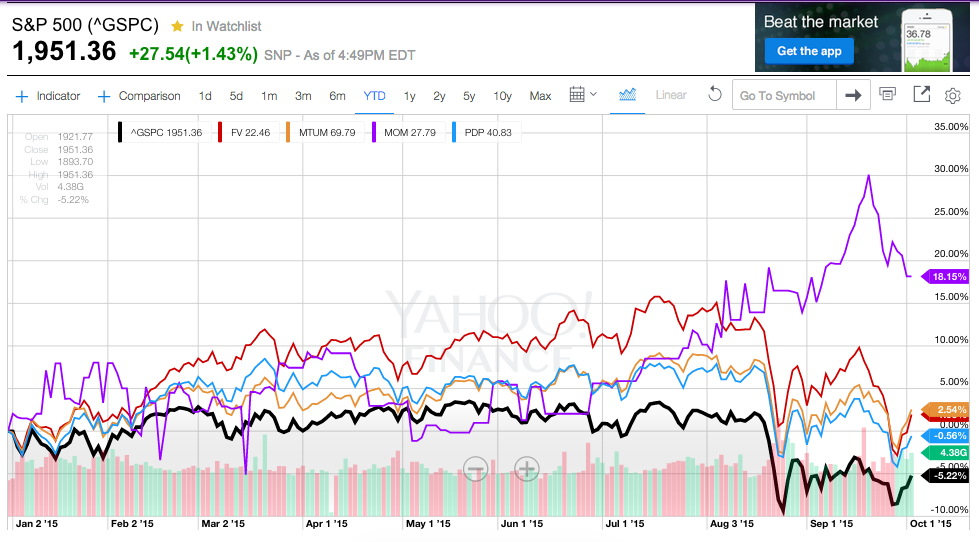
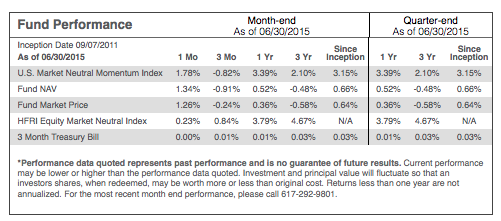



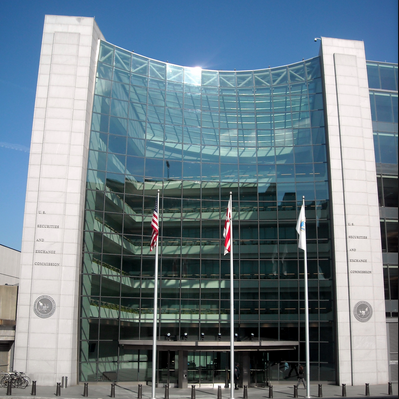

 Better Cryptocurrency to Buy Right Now With $2,000: Ethereum vs. Cardano
Better Cryptocurrency to Buy Right Now With $2,000: Ethereum vs. Cardano

